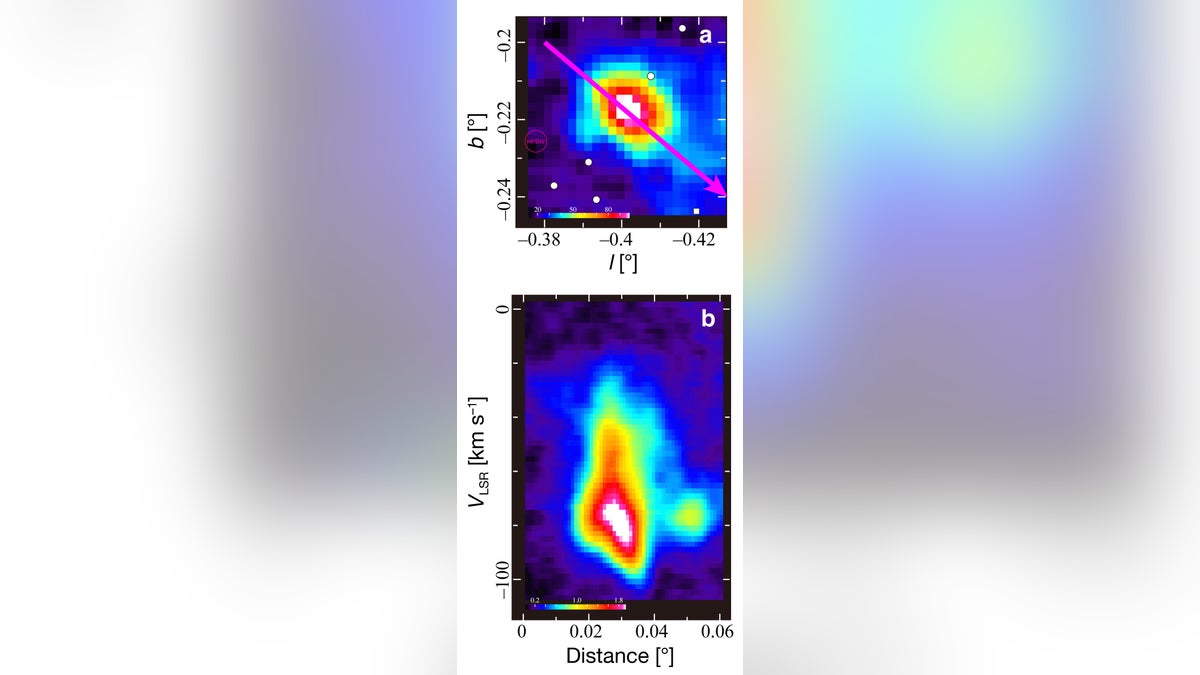
Illustration. (Tomoharu Oka, Keio University)
There seems to be a massive black hole lurking in the Milky Way.
Using the Nobeyama 45-meter radio telescope, a team of astronomers led by Tomoharu Oka, a professor at Keio University in Japan, came to that conclusion after first spotting an enigmatic gas cloud called CO-0.40-0.22, located only 200 light-years away from the center of the Milky Way.
Related: Worldwide telescope network will take best-ever images of Black Holes
It quickly became clear this was not your typical gas cloud, since it contains gas with a very wide range of speeds. Researchers also found the cloud has an elliptical shape and consists of two components: a compact but low density component with a very wide velocity dispersion of 100 km/s, and a dense component extending 10 light-years with a narrow velocity dispersion.
They ruled out a supernova explosion, after X-ray and infrared observations did not find any compact objects in the cloud.
Related: Discovery of black hole 12 billion times bigger than the sun challenging growth theories
Then, the team performed a simple simulation of gas clouds flung by a strong gravity source. In the simulation, the gas clouds are first attracted by the source and their speeds increase as they approach it, reaching maximum at the closest point to the object. After that, the clouds continue past the object and their speeds decrease.

CO-0.40-0.22 seen in the 87 GHz emission line of SiO molecules. (Tomoharu Oka, Keio University, NAOJ)
“As far as we know, the best candidate for the compact massive object is a black hole,” Oka, the lead author of the paper that appeared in the Astrophysical Journal Letters, said in a statement.
The researchers believe they could be seeing something called an “intermediate mass” black hole, which, if true, would be the first time an object of this kind was detected. It could also open the door to a new way of searching for the tens of millions of black holes that some scientists believe are out there in the Milky Way Galaxy as welll as proving critical to understanding the birth of the supermassive black holes located in the centers of galaxies.
Related: Rare galaxy found with 2 black holes - one starved of stars
Astronomers already know about two sizes of black holes: stellar-mass black holes, formed after the gigantic explosions of very massive stars; and supermassive black holes (SMBH) often found at the centers of galaxies. A number of SMBHs have been found, but no one knows how the SMBHs are formed. One idea is that they are formed from mergers of many intermediate mass black holes. But so far, no firm observational evidence for intermediate mass black holes has been found.
“Investigations of gas motion with radio telescopes may provide a complementary way to search for dark black holes,” Oka said. “The ongoing wide area survey observations of the Milky Way with the Nobeyama 45-m telescope and high-resolution observations of nearby galaxies using the Atacama Large Millimeter/submillimeter Array (ALMA) have the potential to increase the number of black hole candidates dramatically.”
